The long march against extractivism in Ecuador The case of the Andean Chocó
Topics
Regions
In a historic vote, Ecuadorians banned oil drilling in Yasuní and mining in Chocó Andino. This essay explores the clash between environmental defenders and neoliberal extractivism, revealing a nation deeply divided.
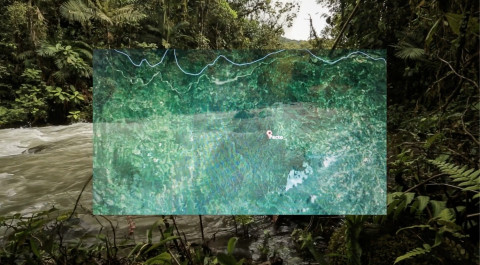
Quito sin minería, video still, A4C 2021
Introduction
In August 2023, in an unprecedented landslide victory, the majority of Ecuadorean people voted to support a ban on oil drilling in Yasuní in the Amazon rainforest and to stop the expansion of mining in the Chocó Andino in the Pichincha province, near the country’s capital, Quito. 1
The struggle to “keep oil underground” in Yasuní had gone on for more than 10 years, beginning when movements from the cities and the countryside, indigenous organizations and ecological actors coalesced around the Yasunidos 2 umbrella. Yasunidos managed to gather more than seven hundred thousand signatures on a petition to stop oil exploration in the ITT Yasuní, home of various endangered species and uncontacted indigenous peoples. Most of the signatures were arbitrarily nullified by President Rafael Correa in an attempt to cancel the petition.
His government had previously launched a similar proposal that envisaged the creation of an international compensation fund to account for the losses generated by the decision to keep oil underground. The government’s plan was then shelved, allegedly because of negotiations underway to grant concessions to oil companies in the same area, while the plan proposed by Yasunidos did not include any form of financial compensation. Yasunidos reverted to legal channels, while Correa and his government launched a campaign to discredit and delegitimize the movement. Finally, a ruling of the Constitutional Court recognized the validity of the signatures and called for a nation-wide consultation.
Interestingly, the victory in the national and local consultations on environmental matters happened on the same day that right-wing neoliberal candidate Daniel Noboa won the presidential elections. Two countries emerged in the polls, each of them with a completely divergent worldview, one embedded in neoliberal capitalism and the other in the struggle against extractivism and for the defense of territories. What Colombian anthropologist Arturo Escobar described as “ontological conflicts”3 happening at the territorial levels expanded throughout the whole country, whose economy has traditionally been dependent on extraction of resources.
The upcoming elections in Ecuador once again bring to a head the clash of these conflicting visions for Ecuador’s prosperity. With a specific focus on the Andean Choco region, this essay looks at the strategies used by local communities in Ecuador to defend their territories and the rights of nature. Such strategies have been multiple, ranging from marches, demonstrations, setting up permanent watch-posts, road blockades, to using legal litigation and the opportunities offered by the Constitution of Ecuador. It also looks at the methods used by neoliberal capitalism, sometimes with assistance from the state, such as criminalization of resistance, the recurrent use of lawfare and downright harassment and oppression.
Challenging Extractivism
In 2022, the 50th anniversary of the first barrel of oil was celebrated as a watershed moment in the country’s history, something that shaped its culture, politics, and landscapes.4 The original footage of a documentary of that time showed a bishop blessing the first drop of “black gold” and the first barrel of oil being brought on a tank in a procession surrounded by gloomy-faced indigenous women- the plastic and visual embodiment of extractive violence.5 Racist, colonial, patriarchal, founded on force. Since then, extractivism has been a constant determinant of the economic, political and social fabric in Ecuador. The violence of capital and state has been part of the daily lives of thousands of indigenous peoples and local communities in resistance. With this in mind, the outcomes of the consultations on Yasuní and the Chocó Andino cannot be understood unless they are situated in the broader context related to the ongoing debate on post-extractivism and local struggles against mining and oil drilling.
While territorial resistance against oil drilling has been recurrent in Ecuadorean social and environmental struggles, opposition to mining has gained ground due to growing global demand for copper and gold, in addition to the search for raw materials for the energy transition. The extraction of balsa wood for export to China to assemble wind blades for the expanding renewable energy sector in the country has brought about devastating impacts in indigenous peoples’ populated rainforests.6
This is one of the many examples of what Argentinian sociologist Maristella Svampa and academic Breno Bringel call “The decarbonization consensus”7, to explain how “green transition” embedded in an extractivist, pro-growth, capitalist framework will result in an all-out attack on communities and fragile and protected ecosystems. Accordingly, nature is considered only as a reservoir of raw materials - in this case to advance “decarbonization” - while generating widespread negative impacts on biodiversity, thereby paradoxically undermining the capacity of the Earth’s ecosystems to function as carbon sinks or reservoirs.
Territorial resistance to extractivism in Ecuador is peculiar in its blend of different strategies shaped around the right to resistance, to consultation, or the Rights of Nature recognized in the constitution of 2008.8 A section of the Constitution dedicated to the Rights of Nature or "Pachamama" recognizes Pachamama as a legal entity, and respects nature's right to exist and to the care and regeneration of its own life cycles, functions and evolutionary processes. The Rights of Nature have proven to be a powerful tool to stop destructive projects through the recognition of legal personhood of endangered ecosystems or species or recognizing their intrinsic values.
In the Llurimagua case9 two endangered frog species, the Long-nosed harlequin and the Confusing rocket frog of Intag went to court represented by communities in the Imbabura region of Northern Ecuador, who decided to file a lawsuit to stop a mining concession to the Chilean state-owned company CODELCO. This was a $3 billion project to mine copper and molybdenum, approved at the time without the necessary environmental impact assessments and without consulting local communities. In fact, the crux of the legal case was about whether to respect or violate rights of nature. The case was resolved in the first instance in favor of the two frogs, but CODELCO prevailed in the appeal. In March 2023, a local court withdrew CODELCO’s license.10
In 2019, the victory of anti-mining movements in a regional consultation in Azuay led to the total ban of large-scale mining in the watersheds and the paramo “highlands”. Nevertheless, and due to legal loopholes in the consultation queries, some large-scale mining operations went ahead. Movements also won a major victory against Canadian company Dundee Precious Minerals in August 2023 when plans to start operations in Loma Larga, Kimsacocha11 were interrupted by a court ruling that condemned the Ecuadorean Ministry of Environment, Water and Ecological Transition for violating the right of indigenous peoples to be properly consulted and violating the rights to water and of nature. 12
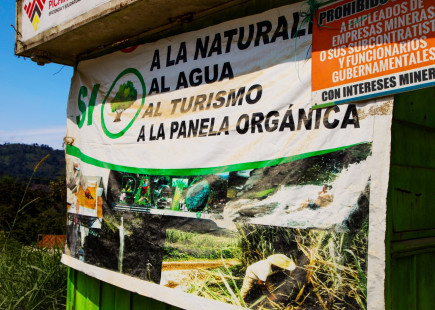
Rosa Jijòn, A4C-Artsforthecommons

Rosa Jijòn, A4C-Artsforthecommon
As these cases show, such an unprecedented combination of legal instruments, alliance-building and territorial resistance has offered rural communities, indigenous peoples and urban movements the opportunity to forge alliances and challenge the extractivist model imposed by governments, both left and right.
Resistance flourished throughout the mineral-rich Andean region, from Buenos Aires to Palo Quemado13 to the Shuar territories, which have been traditionally hostile to Western capitalist penetration 14. Most of the biodiverse areas and indigenous territories in the Cordillera del Condor in the Amazon province of Morona Santiago have been turned into mining concessions for Chinese and Canadian companies. In Fierro Urco, canton Loja, communities that protested the presence of mining company Guayacan Gold denounced the heavy militarization of their territories and the criminalization of community activists15. In Palo Quemado and Las Pampas in Sigchos, in Andean province of Cotopaxi, indigenous resistance suffered the effects of fierce reaction and violent repression by the Ecuadorean army. In spring 2024, communities had rejected the result of a fake consultation organized by Canadian mining company Atico, held under duress, thus violating constitutional requirements. In the Merced parish of Buenos Aires in Imbabura, the community declared itself in resistance, between the rock of Australian company Hanrine and the hard place of military repression16 and widespread illegal mining.

Rosa Jijòn, A4C-Artsforthecommon
Tracing the impacts
Illegal gold mining is now one of the key sectors for money laundering by drug traffickers17 that control much of the coastal territories of the country and led the country into a dramatic surge in violence and a semi-permanent state of emergency. Communities in the Pacto parish suffer a similar condition: illegal mining for gold is rampant, but in fact the real stake lies in the huge deposits of copper. Illegal mining is just the first step, and what follows it to leave the space to mining companies under the promise - or better, mirage - of sustainable mining. The response has always been the same: repression and militarization spilling over to communities and movements.18
Mining companies initiated exploration activities in the Chocó almost 20 years ago with the alleged connivance of Ecuadorean authorities and without any free and prior consultation with local communities. As many as 24 mining concessions have been granted in an area of approximately 27,762 hectares, two of which are for large scale mining and 12 for smaller scale operations. Current and projected impacts of mining in the biodiversity corridor of the Chocó, home of the endangered “Spectacled bear (Oso de Anteojos)” are substantial.
Between 1996 and 2007 unauthorized use of water springs caused pollution with high levels of arsenic, copper, cadmium, chrome, and lead. Water streams such as Chirapi and Pishashi were contaminated with mining waste and this in turn impacted on water supplies to communities and for animal husbandry activities. Large scale concessions led to the diversion of rivers, thereby reducing water supply and also affecting the city of Quito’s access to water.
It should be recalled that, apart from the “Oso de Anteojos,” other rare species live in the region, and the fragmentation of soil in Pacto has led to the destruction of their natural habitat. Recorded plant species represent 12.5% of the country’s flora, including 76 endangered species. For its unique characteristics, the Chocó andino has been given the status of a Biosphere Reserve by UNESCO.19 According to the Ecuadorean Observatory of Socio-environmental conflicts20, conflict over mining in the Chocó date back to the 1980’s when neoliberal policies pursued by Ecuadoran governments paved the way for large scale foreign direct investments in the mining sector, a period referred to as the so-called “commodities boom”.

Rosa Jijòn, A4C-Artsforthecommon

Rosa Jijòn, A4C-Artsforthecommon
Shifting strategies
Parallel to resistance efforts, initiatives for the protection of ecosystems and the development of alternative revenue generation activities- such as ecological tourism- began to take shape. With the advent of the “Revolución Ciudadana” headed by the then President Rafael Correa, free-market actors were substituted by the State, which enjoyed the support of international capital. The state pursued a strategy of expanding the extractive frontier with the purpose of generating hard currency needed to finance its social and infrastructure programs. As in other counties in Latin America, progressive governments found themselves in a conundrum: pay back historical social debt to marginalized classes or accumulate an ecological debt for the generations to follow. The government’s choice in this contradiction resulted in the repression of ecological and indigenous movements that offered resistance.
In the Chocó Andino, resistance strategies were challenged with harassment threats, divide-and-rule actions, and the co-optation of community members. This situation caused local organizations to shift from confrontation on the field, to legal strategies while maintaining some sort of permanent presence in the areas allotted for exploration, while criminalization of leaders went on unabated. In Pacto, where as many as 12 illegal concessions are currently operating without prior consultation or transparency on potentially affected protected areas, one of the companies has been threatening people, with armed men visiting their farms. Another company has filed lawsuits against 30 locals, accusing them of sabotage and intimidation.
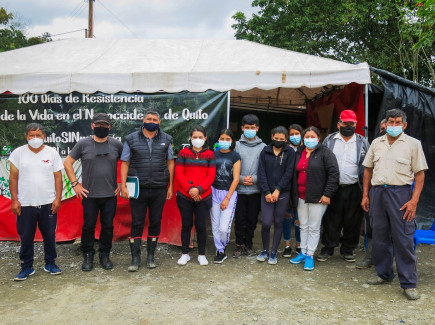
Rosa Jijòn, A4C-Artsforthecommon
One of the defenders that suffered the effects of “lawfare” is Yari Tenorio Barragan, a lawyer of African descent, who explains: “The Andean Chocó, composed of 6 rural parishes, is one of the most biodiverse regions in the world, just a stone’s throw away from the capital. It is a territory in “re-existence” against metal mining and thriving with alternative opportunities to generate income and livelihoods. I have been working in support of the Pacto community since 2020 and since then I have increasingly engaged in anti-mining resistance in other parts of the country, like Buenos Aires.”
This territory has a long history of resistance to extractivism, one of the highlights having been the struggle against the OCP (Oleoducto de Crudos Pesados, a pipeline to transport heavy oil for processing and export) in the adjacent cloud forests of Mindo. “ The strategies followed by the community in Pacto are multiple, ranging from setting up permanent watch-posts, to road blockades, to using legal litigation and the opportunities offered by the Constitution. Criminalization of resistance, and recurrent use of lawfare were widespread all along the country and reached Pacto as well. This led the community to rethink its approach”.
Legal resistance strategies included crafting alliances with local administrations, the establishment of a new administrative unit, the “Mancomunidad”, an umbrella organization of the various municipalities in the area, exerting pressure on central government to carry out inspections and gather information on ongoing activities of mining companies.
Inty Arcos is a biologist specialized in Ecology and Sustainable Development. He is also the coordinator of the Chocó Andino Model Forest and researcher at the Imaymana Foundation. He explains what the Quito sin Mineria movement is and how it was born: “Quito sin Mineria is a collective that brings together various organizations, individuals and civil society representatives, communities and local authorities with the purpose of opposing (the) mining of metals (gold and copper) in the biosphere reserve of the Andean Chocò. It is part of a decade long struggle against mining throughout the country. We decided to join forces between local and community organizations and urban groups, students and university collectives, workers that offered their support. They realized the importance of the Andean Chocò and of its future and the need to protect it so that it can provide for healthy food and water, to regulate climate, preserve biodiversity, or for recreational purposes. We made alliance with other organizations like the Frente de Defensa de Pacto, la Red de Mujeres, feminist and youth collectives in Quito, animal right groups and some NGOs “.
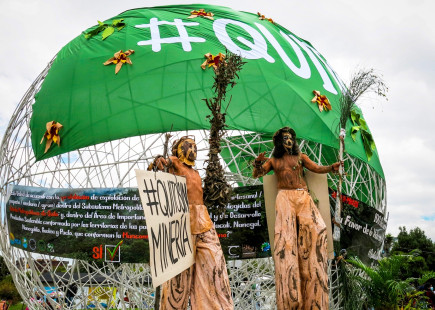
Rosa Jijòn, A4C-Artsforthecommon
Quito sin mineria’s 21 key goal was that of filing a request for a popular consultation. Forms with signatures in support of the 4 consultation questions were delivered in March 2021 when a diverse and colorful parade of activists, artists, and movement leaders marched from the Parque del Arbolito, close to the historical center of Quito and historical symbol of popular resistance, to reach the Constitutional Court.22 Signatories requested the restriction of metal mining in the subsystem of protected areas in the Quito metropolitan territory and in the Mancomunidad del Chocó Andino.
“We were denied this possibility twice, at the third time the bond between urban and rural sectors made the difference. The inhabitants of Quito wanted to protect their “lung” and went to the polls. As much as 72% of the overall population voted against mining, and the behavior of mining companies – Yari pointed out - They rejected the companies’ violation of our right to consultation and of the rights of nature. We received the solidarity of those that struggled against the OCP, they supported our permanent watch-posts, bringing food and other goods. Academics and international activists came to visit”.
In parallel, communities work to develop income-generation schemes that offer a viable alternative to extractivism, from nature conservation and ecotourism programs to the expansion of production of “panela”, certified brown organic sugar for export through fair trade networks.

Rosa Jijòn, A4C-Artsforthecommon
The road ahead is still fraught with obstacles, but hopes and expectations remain high. As Arcos points out: “the result of the consultation is not retroactive, so we have to continue struggling using legal avenues. Some of the large companies have already pulled out. Hanrine from Australia for instance that held a mining concession of 9000 hectares while other smaller companies will have to leave because the public consultation results in a ban on further concessions for exploration and extraction. We are hopeful that all companies will leave in full compliance with the law and popular will, considering also that there are only 7 biosphere reserves in the country, and the Choco is one of them together with others such as the Galapagos or Yasuni.“.
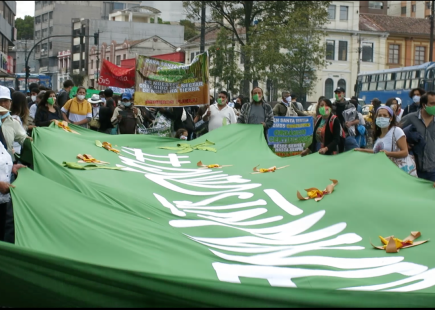
Rosa Jijòn, A4C-Artsforthecommon

Rosa Jijòn, A4C-Artsforthecommon
In a move that will further bolster communities resistance to mining, a local court in the region of Pichincha recognized that illegal mining has violated the rights of nature of the Chocò Andino and instructed the government and relevant institutions to compensate for and mitigate the damage wrought by decades of exploitation23.
Movements and organizations continue to hold a series of initiatives to call on the national government and the Constitutional Court to comply with the results of the two consultations. Despite current President Noboa’s reassurance that Yasuni will never be exploited, no concrete step has been undertaken so far to fully implement the outcome of the consultation. Rather, more mining concessions have been granted throughout the country,24 thus reconfirming the extractivist pattern that has characterized the country’s economy for decades. The platform of a two-week long successful protest against the construction of a high-security prison in the Amazon province of Napo in December 2024 was widened to encompass opposition to mining and oil drilling in the whole country.
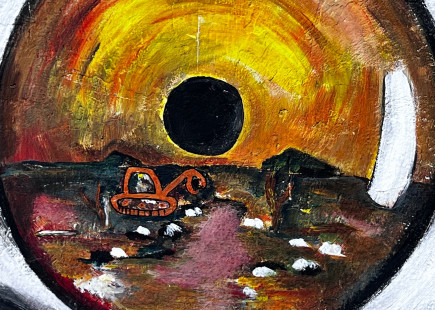
Rosa Jijòn, A4C-Artsforthecommon
Conclusion
The upcoming presidential elections in February 2025 will be a testing ground for conflicting interests, with the Indigenous-led party Pachakutik heralding the end of extractivism, rights of indigenous peoples and rights of Nature, while potential progressive allies still hesitate to make this a key topic in a common alliance of leftist and popular movements. In the meantime, indigenous mobilizations are resuming across the country. In the end, the rights of nature and the best interests of the people should be the guiding principles for any government that wishes to take Ecuador forward into a glorious, healthy, just and equitable future. However, as the stories in this paper show, this will not happen without coordinated and relentless resistance against the rapacious needs of neoliberal capital.
La lucha sigue.